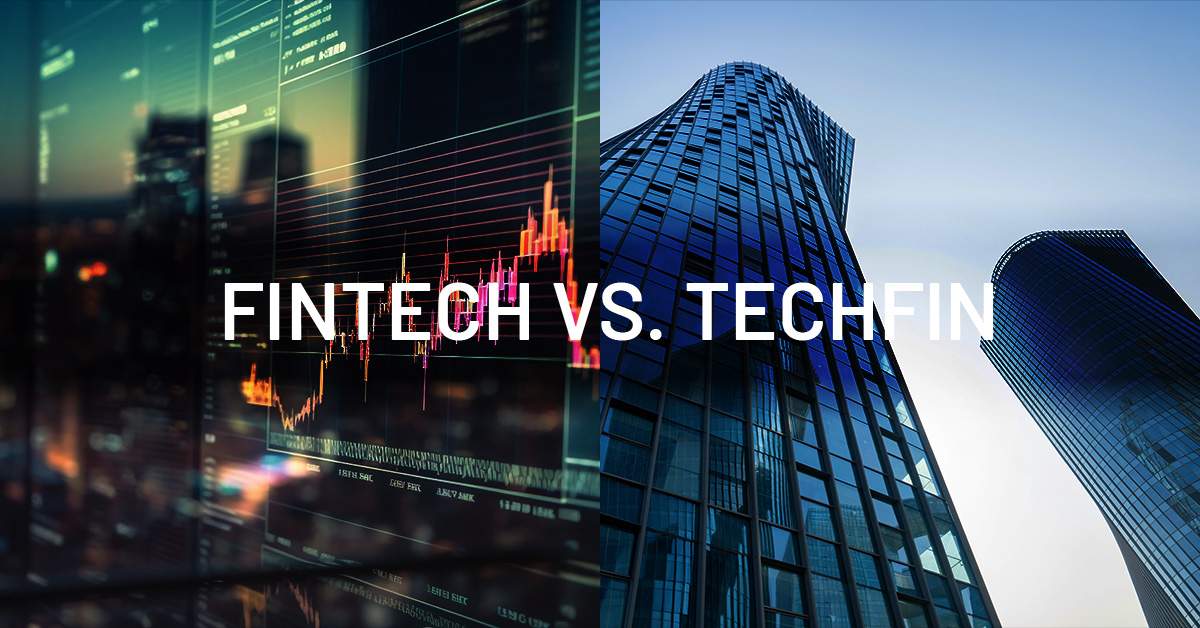Page Contents
Introduction
A growing number of consumers anticipate that financial services and products will be easily incorporated into their everyday routines, such as paying for parking when they arrive at a lot or getting financing instantly at the point of sale. These integrated experiences, at their core, are not just “digital financial services”; they are the next financial revolution. The financial industry has been shaken in recent years by FinTech firms, but Big Tech’s emergence and expansion into the sector is altering things once again. The financial industry is expected to see a major impact from emerging fields like Fintech and TechFin. Thus we decide to dive deep in understanding fintech vs techfin.
The Fintech ecosystem plays a substantial role in the progression of IFSCs. The IFSCA, in April 2022 released a comprehensive ‘Framework for Fintech Entity in the IFSCs’ which set the stage for a global fintech hub right in GIFT City. This framework covers #FinTech and #TechFin entities. Let’s delve into the core of these terms, especially in the context of the GIFT IFSC framework:
What is FinTech?
Fintech, an acronym for financial technology, refers to innovative technology designed to enhance and streamline the provision and use of financial services. Fintech is primarily used to assist organisations, entrepreneurs, and customers in managing their financial operations, procedures, and lifestyles more effectively. It is made up of algorithms and specialised software that are utilised by computers and cellphones. The term “financial technology” is reduced to “fintech.” This refers to emerging financial technologies and innovations that drive new business models, applications, processes, or products in areas connected to financial services. These are typically B2C in nature. 𝘍𝘰𝘳 𝘦𝘹𝘢𝘮𝘱𝘭𝘦 – 𝘗𝘢𝘺𝘵𝘮, 𝘊𝘳𝘦𝘥, 𝘙𝘢𝘻𝘰𝘳𝘱𝘢𝘺, 𝘗𝘰𝘭𝘪𝘤𝘺𝘣𝘢𝘻𝘢𝘢𝘳, 𝘗𝘪𝘯𝘦𝘭𝘢𝘣𝘴, 𝘚𝘭𝘪𝘤𝘦, 𝘦𝘵𝘤.
The creation and usage of cryptocurrencies, like Bitcoin, is also included in fintech. Even while that particular fintech sector may garner the most attention, the multi trillion-dollar market capitalization of the conventional global banking sector still holds the key to success. Fintech has taken off since the middle of the 2010s, with established financial organisations either buying up new enterprises or expanding their existing fintech products, and startups obtaining billions in venture funding—some of which have gone on to become unicorns. Digital tokens (such as non-fungible tokens, or NFTs), digital cash, and cryptocurrency (such as Bitcoin, Ethereum, etc.). These frequently make use of distributed ledger technology (DLT) called blockchain, which keeps records on a network of computers without the need for a central ledger. Smart contracts, which use code to automatically carry out agreements between parties like buyers and sellers, are another feature of blockchain technology.
Regtech, which aims to assist financial services companies in adhering to industry compliance regulations, particularly those pertaining to Know Your Customer procedures that prevent fraud and Anti-Money Laundering laws. Algorithms are used by robo-advisors like Betterment to automate investing advice in order to reduce costs and improve accessibility. Fintech is most often used and recognised in these domains. Services that are underbanked or unbanked that aim to help underprivileged or low-income people who are neglected or underserved by conventional banks or financial services firms. Financial inclusion is promoted by these apps online safety. Fintech and cybersecurity are linked because of the spread of cybercrime and the decentralised storage of data. The emergence of AI chatbots in 2022 is another illustration of fintech’s growing influence on daily life. The idea behind open banking is that anybody should be able to access bank data in order to develop apps that link financial institutions and outside vendors. One such product is Mint, an all-in-one money management application. Insurtech aims to employ technology to simplify and optimise the insurance sector.
What is TechFin?
These are advanced or innovative technological solutions primarily designed to support, aid, The term “Techfin” refers to a technological firm that joins the financial industry with cutting-edge offerings that, of course, meet the demands of the business. This explains how it relates to banking and financial commitments. To put it briefly, it describes businesses that introduce financial solutions that are incorporated into internal management systems, utilizing financial resources and offering a consolidated view of data through a single interface. Alibaba’s founder, Jack Ma, is credited with coining the phrase, dubbed the “Amazon of China.” Financial goods were integrated into well-known apps by the investor and entrepreneur, who also included the BATs (Baidu, Alibaba, Tencent) to build the first techfin model. and enhance activities related to financial products, services, and institutions. These are typically B2B in nature where they have tech products which can be used by financial institutions for their operations. 𝘍𝘰𝘳 𝘦𝘹𝘢𝘮𝘱𝘭𝘦 – 𝘍𝘪𝘯𝘢𝘤𝘭𝘦 (𝘣𝘺 𝘐𝘯𝘧𝘰𝘴𝘺𝘴), 𝘔𝘢𝘮𝘣𝘶, 𝘉𝘳𝘰𝘬𝘦𝘳𝘌𝘥𝘨𝘦, 𝘐𝘯𝘴𝘶𝘳𝘦𝘊𝘙𝘔, 𝘖𝘋𝘐𝘕, 𝘦𝘵𝘤
While FinTech firms start with finance and use technology to improve upon these services, TechFin companies start with technology and venture into the financial sector leveraging their tech strengths. One of the main issues that techfins resolves is the process of integrating and updating financial information, which is a major barrier to effective customer service for banks and cooperatives. Tech platforms are said to be able to cut the amount of time that specialists need to spend integrating a file in half.
How does one use Techfin?
Techfin is a technology business that focuses on offering cutting-edge, contemporary financial services that are driven by data, technology, and clientele.
Compared to traditional market suppliers, they provide financial services that are optimised and differentiated by utilising their current client base and data knowledge.
Techfins gathers data for itself through these financial solutions, but they concentrate on discovering consumer demands, payment patterns, and latent wants in order to maximise commercial potential. With their B2B focus, techfin businesses naturally aim to simplify and make widely accessible the conventional procedures managed by enterprises and financial institutions. Its goal is to gather and analyse consumer-generated data by generating centralised data through the deployment of user-friendly resources, solutions, and interfaces.
Techfins provide financial capabilities to an organization’s traditional platform in an easy-to-use manner, reaching out to businesses who may not necessarily be in the segment.
Given that many businesses lack experience with financial goods, Techfins offers specialised services that make it easier to solve problems and get rid of barrier
Advantages that Techfin offers
A techfin can offer a wide range of activities and services to many organizations across various industries, including:
- Customised services via fostering an information-sharing culture that supports customer support and product development.
- Due to direct communication with the financial service provider, technological deployment may be completed more quickly. This allows for a focus on customer service thanks to the systems’ and platforms’ ease of use.
- Practicality, by granting clients access to financial services contingent only on their status as clients or users of the company.
- Reducing mistakes since management is carried out by automated tools and subject matter experts, streamlining workflow and enhancing the management and operation of the company. Thanks to digital solutions, there are less errors in documents that customers give.
- Less errors in papers supplied by customers, as a result of digital systems that carry out workload-saving automated inspections.
- Analytical data that is included into the technology ecosystem of the business and provides the foundation for the analysis of financial data.
- Automating procedures for establishing connections with credit and legal agencies would enable workers and clients to make quick decisions by providing them with instant information.
- Protection by means of instruments like digital or electronic signatures.
identity verification using two-step authentication or biometric techniques. - Integration with several technologies, including BPMS (Business Process Management Suite), CRM (Customer Relationship Management), and others.
What are the major differences between Fintech and Techfin?
|
Feature |
Fintech |
Techfin |
|
Origin |
Financial services industry |
Non-financial tech companies |
|
Core Focus |
Providing financial services using technology |
Integrating financial services into existing tech ecosystem |
|
Customer Targeting |
Primarily new customers in the financial sector |
Existing customers using their existing technology platforms |
|
Innovation Focus |
Disrupting or improving existing financial services |
Enhancing existing tech ecosystem with financial functionalities |
|
Regulatory Landscape |
Subject to strict financial regulations |
May utilize existing regulations or require new frameworks |
|
Competitive Landscape |
Highly competitive with diverse players |
Relatively concentrated with established brands |
|
Funding Sources |
Venture capital, angel investors, financial institutions |
Existing revenue streams, corporate investments |
|
Key Technologies |
Blockchain, AI, mobile payments, open banking |
APIs, cloud computing, big data analytics, AI |
|
Examples |
Revolut, Robinhood, N26 |
Apple Pay, Amazon Pay, WeChat Pay |
|
Overall Impact |
Transforming traditional financial services |
Expanding access to financial services within established tech ecosystems |
Conclusion
The financial landscape is constantly evolving, driven by two key forces: Fintech, the innovative disruptors leveraging technology to reshape financial services, and Techfin, the established tech giants expanding their reach into the financial realm. While both share the goal of enhancing financial experiences, distinct approaches and advantages set them apart.
- Fintech: Born from agility and innovation, Fintech startups often target specific pain points in the financial sector, delivering cutting-edge solutions beyond traditional offerings. Their nimbleness and focus allow for rapid iteration and experimentation, fostering new technologies like blockchain and AI. However, navigating regulations and building trust, especially for newcomers, can be challenging.
- Techfin: Leveraging existing user bases and brand loyalty, Techfin giants like Apple and Amazon can offer integrated financial services within their established ecosystems. This seamless integration creates convenience and expands financial access, but concerns about data privacy and potential anti-competitive practices arise.
- Advantageous Intersection: Both Fintech and Techfin play crucial roles in driving financial progress. Fintech’s disruptive spirit pushes boundaries, while Techfin’s scale and resources accelerate adoption. Collaboration and healthy competition between the two create a vibrant ecosystem that benefits consumers and the industry as a whole.
- Choosing the Right Path: The “better” option depends on the specific context and needs. Startups might benefit from Fintech’s innovative solutions, while established organizations could consider partnering with Techfin giants for wider reach.
In conclusion, the Fintech vs. Techfin debate is not a binary choice. Both approaches contribute to a dynamic and inclusive financial future. As technology continues to evolve, understanding their differences and potential synergies will be crucial for navigating the exciting journey ahead.
FAQs on Fintech vs Techfin
- What is Fintech?
Fintech refers to new financial technologies developed by independent startups aiming to disrupt traditional financial institutions. They provide innovative solutions like digital payments, online lending, and alternative investment platforms.
- What is Techfin?
Techfin, on the other hand, represents established financial institutions like banks and insurance companies adopting and integrating technology into their existing offerings. They aim to improve efficiency, reach new customer segments, and compete with agile Fintech players.
- What are the advantages of Fintech?
- Agility and Innovation: Unburdened by legacy systems, Fintech companies can develop and deploy new solutions faster.
- Customer Focus: Fintech often prioritizes a user-centric approach, leading to intuitive and accessible financial services.
- Targeted Solutions: Fintech startups can cater to niche markets or specific customer needs that traditional institutions might overlook.
- What are the advantages of Techfin?
- Regulatory Compliance: Established institutions already possess the necessary licenses and infrastructure to operate within regulations.
- Financial Stability: Techfin firms benefit from the financial backing and risk management expertise of their parent institutions.
- Trust and Brand Recognition: Consumers often have existing trust in established financial brands, giving Techfin solutions a head start.
- Which is better, Fintech or Techfin?
Neither approach is inherently “better.” The optimal choice depends on the specific context and needs. Consider factors like the target market, desired level of innovation, and regulatory requirements.
- Can they work together?
Absolutely! Collaboration between Fintech and Techfin is becoming increasingly common. Fintech startups can partner with established institutions to leverage their reach and resources, while Techfin firms can benefit from the agility and innovation of Fintech partners.
- What are some examples of Fintech companies?
- Nubank (digital bank)
- Robinhood (investment platform)
- Affirm (buy now, pay later)
- PayPal (online payments)
- What are some examples of Techfin initiatives?
- Mobile banking apps by traditional banks
- AI-powered fraud detection systems
- Blockchain-based payments solutions offered by financial institutions
- Robotic advisors for wealth management
- What is the future of Fintech and Techfin?
Both sectors are poised for continued growth and evolution. We can expect further convergence, collaboration, and regulatory adaptation as they reshape the financial landscape.
- Where can I learn more?
Stay updated on the latest trends and developments by following industry publications, attending conferences, and exploring resources from organizations like the Global Fintech Hub and the Moxey Report.










